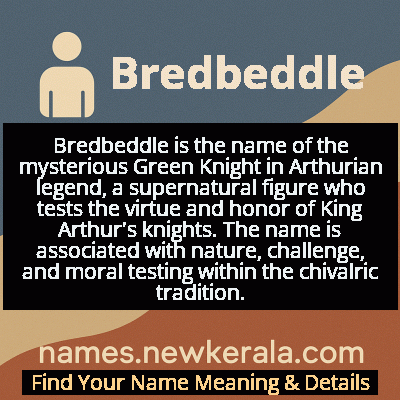Bredbeddle Name Meaning & Details
Origin, Popularity, Numerology Analysis & Name Meaning of Bredbeddle
Discover the origin, meaning, and cultural significance of the name BREDBEDDLE. Delve into its historical roots and explore the lasting impact it has had on communities and traditions.
Name
Bredbeddle
Gender
Male
Origin
Arthurian
Lucky Number
7
Meaning of the Name - Bredbeddle
Bredbeddle is the name of the mysterious Green Knight in Arthurian legend, a supernatural figure who tests the virtue and honor of King Arthur's knights. The name is associated with nature, challenge, and moral testing within the chivalric tradition.
Bredbeddle - Complete Numerology Analysis
Your Numerology Number
Based on Pythagorean Numerology System
Ruling Planet
Neptune (Ketu)
Positive Nature
Intuitive, analytical, spiritual, and inquisitive.
Negative Traits
Secretive, reserved, aloof, and can be overly critical.
Lucky Colours
Green, yellow.
Lucky Days
Monday.
Lucky Stones
Cat’s eye, moonstone.
Harmony Numbers
1, 5, 6.
Best Suited Professions
Scientists, researchers, spiritual leaders, detectives.
What People Like About You
Depth of knowledge, analytical skills, spirituality.
Famous People Named Bredbeddle
Sir Bredbeddle
Arthurian Knight
The Green Knight who challenged Gawain in the famous beheading game
Bredbeddle of the Green Chapel
Mystical Figure
Supernatural knight representing nature's enduring power
Bertilak de Hautdesert
Noble Lord
Human identity of the Green Knight who tested Gawain's virtue
Name Variations & International Equivalents
Click on blue names to explore their detailed meanings. Gray names with will be available soon.
Cultural & Historical Significance
The Green Knight's significance extends beyond mere antagonist; he functions as a necessary corrective to Arthurian pride and complacency. His dramatic entrance during Christmas festivities—a time of Christian celebration—underscores the tension between established religion and older pagan beliefs. The year-long waiting period between challenge and fulfillment mirrors agricultural cycles and seasonal patterns, emphasizing nature's patient but inexorable rhythms. Through his dual identity as both terrifying challenger and gracious host Lord Bertilak, Bredbeddle embodies the medieval understanding that true tests of character often come in disguised forms, and that wisdom and virtue must be earned through confronting uncomfortable truths about oneself.
Extended Personality Analysis
Bredbeddle exhibits a complex personality that blends theatrical grandeur with profound moral purpose. As the Green Knight, he demonstrates remarkable boldness and showmanship, crashing Arthur's Christmas feast with dramatic flair to issue his supernatural challenge. Yet beneath this theatrical exterior lies a being of immense patience and long-term perspective—he willingly waits an entire year for Gawain to fulfill his part of the bargain, suggesting a consciousness that operates beyond human temporal concerns. His cheerful demeanor as Lord Bertilak masks a keen psychological insight, allowing him to test Gawain's virtues through seemingly casual games while maintaining an atmosphere of hospitality and good humor.
This character displays extraordinary emotional intelligence and mercy in his final judgment of Gawain. Rather than condemning the knight for his small deception with the green girdle, the Green Knight recognizes Gawain's essential virtue while gently exposing his human imperfections. He proves to be both stern judge and compassionate teacher, understanding that true honor includes acknowledging one's flaws. His personality embodies the medieval ideal of 'measure'—balance between opposing qualities—as he combines supernatural power with very human understanding, fierce challenge with ultimate forgiveness, and theatrical spectacle with deep moral seriousness. This makes him one of the most psychologically nuanced and compelling figures in Arthurian literature.
Modern Usage & Popularity
In contemporary times, the name Bredbeddle remains exceptionally rare and is primarily confined to scholarly discussions of Arthurian literature and specialized historical contexts. It has not entered mainstream naming practices and is classified by onomastic experts as an 'archaic literary name'—recognizable to specialists but unlikely to be chosen for modern children. The character's recent resurgence in popular culture through the 2021 film 'The Green Knight' has generated renewed interest among Arthurian enthusiasts and fantasy fans, though this has not translated into significant usage as a personal name. The name appears occasionally in fantasy literature, role-playing games, and historical fiction where authors seek authentic Arthurian nomenclature with distinctive character. Its usage patterns reflect what naming scholars call 'cultural reference naming'—employed primarily by parents or creators with specific literary or historical interests rather than following broader naming trends. The name's complexity and strong association with a single, highly specific character further limit its adoption in contemporary naming practices.
Symbolic & Spiritual Meanings
Bredbeddle as the Green Knight carries rich symbolic significance that operates on multiple levels simultaneously. Most fundamentally, he represents nature's enduring power and cyclical renewal—his green coloration connects him to vegetation, fertility, and the eternal return of spring, while his survival of decapitation symbolizes nature's ability to regenerate despite human intervention. He serves as a living embodiment of the challenge principle, representing the idea that true growth and self-knowledge come through facing difficult tests rather than avoiding them. The character symbolizes the integration of apparent opposites: human and supernatural, civilized and wild, Christian and pagan traditions, creating a figure who transcends simple categorization. His dual identity as both terrifying Green Knight and gracious Lord Bertilak represents the medieval understanding that wisdom and moral testing often come in disguised forms, and that true virtue requires seeing beyond surface appearances to deeper truths about character and intention.

